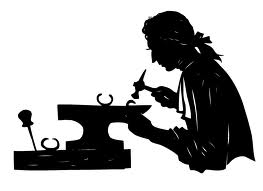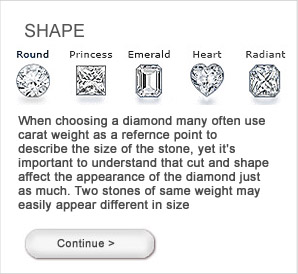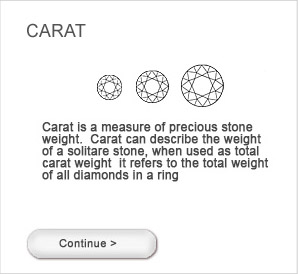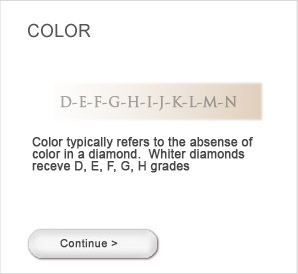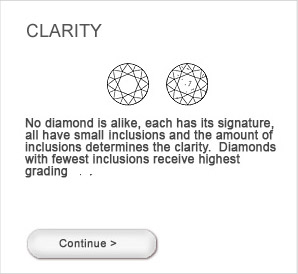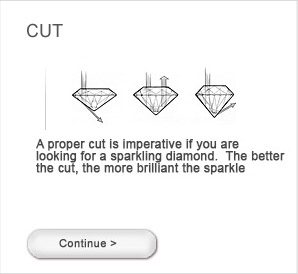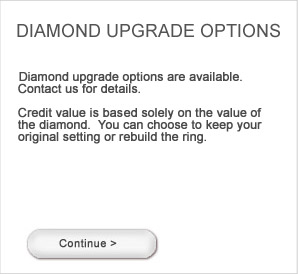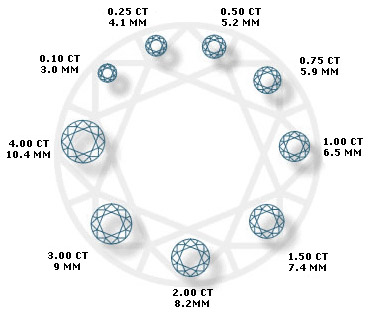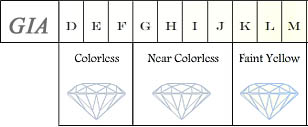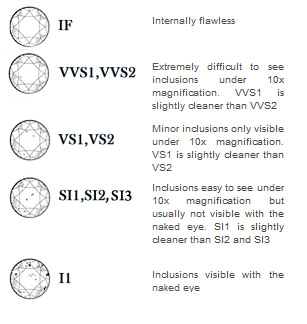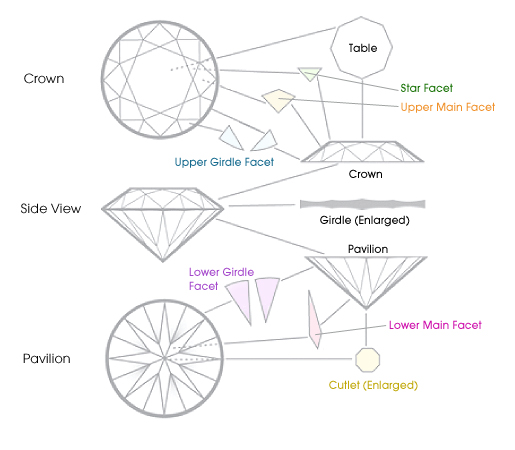Shape,
Carat Weight, Color, Clarity
When
choosing a diamond many often use carat weight as a refernce point
to describe the size of the stone, yet it's important to understand
that cut and shape affect the appearance of the diamond just as much.
Two stones of same weight may easily appear different in size when
viewed from above, which is how the engagement ring is typically viewed.
Flatter cuts will make a diamond appear larger when viewed from top
yet at the expense of brilliance and other important valuable aesthetic
factors.
So
even though carat weight usually translates to approximate size equivalents,
the actual appearance depends on how the diamond is proportioned.
It's important to remember that stones of same weight vary widely
in actual size.
- If you are looking for a diamond that offers fantastic brilliance
and fire, one of the top cuts is the round diamond. The round diamond
is one of the more popular cuts and sometimes referred to as an “ideal
cut”. For many couples looking to tie the knot, the round cut
encompasses beauty and is usually the perfect cut for engagement and
wedding rings. The round cut diamond offers unsurpassed brilliance
and sparkle provided that it is cut to certain specifications.
There are many specific proportions that diamond dealers look for
when selling round diamond cuts; for example, the diamond should use
the Towlkowsky ideal cut method, which follows certain mathematical
principles to shape the diamond ideally. Following the Towlskowsky
ideal cut, the diameter of a premium round cut method should be between
52.4 to 57.5 percent, the girdle thickness should be between thin
and thick, the pavilion should be 42.2% and 43.8% and the crown angle
should be 33.7% and 35.8%Diamond companies will usually indicate that
their diamonds are ideally cut when the measurements and specifications
are within the ideal range set forth by the Towlkowsky method, or
at least very close to it.Round cuts are highly popular in the consumer
market and are used as a center stone and side stones in rings as
well as on other types of fine jewelry. As always, make sure you inspect
the diamond closely or ask for an independent appraisal to determine
the quality of the stone and the retail or wholesale value of it.
Emerald
Cut
- For any woman looking to enjoy the beauty of diamonds, but rather
have pieces that are for the most part understated and subtle, one
of the more interesting diamond cuts that you should look into is
the Emerald cut diamond.
One of the reasons that the Emerald cut diamond is perfect for very
subtle beauty is that the emerald cut diamond reflects less light
than the standard brilliant cuts, as well as it is usually rectangular
in shape. However, If you prefer a more squarish cut, you can still
find antique pieces that display these shapeful characteristics.One
of the ways to enhance a beautiful emerald cut diamond is to pair
it up with side stones. The reason paired stones are perfect for the
emerald cut is that the edges on an emerald cut diamond usually allow
for a variety of stones to be placed alongside.While you can find
beautifully cut emerald diamonds all over the world, one of the most
beautiful emerald cut diamonds come from Israel. New York and Antwerp
are also known to produce well cut emerald diamonds. When choosing
an emerald cut diamond, one of the most important priorities to look
for is the quality of the diamond. It is important to note that every
diamond is not a candidate for an emerald cut; it takes a special
diamond, one that is very high quality and is shaped a specific way
to be eligible for an emerald cut. Any imperfection or inclusion can
be visible when a diamond is cut into the emerald shape. If you are
interested in diamond jewelry that is subtle and understated, take
a look at the emerald cut diamond.
Princess
Cut
- One of the more recent diamond cuts and proving to be incredibly
popular cuts of the last few decades is the princess cut diamond.
The princess cut diamond has grown in popularity due to its wonderful
characteristics of both style and brilliance. If you prefer jewelry
that is unique as well as beautiful, the princess diamond cut should
definitely receive your attention.
Created during the 1980’s, the princess cut diamond reflects
light brilliantly and is typically cut perfectly square. The corners
of the diamond are sharp and uncut. Compared to a round diamond, the
princess cut can offer much more brilliance and fire. A skilled diamond
cutter can make a diamond into a perfectly proportioned princess cut,
which is a perfect-sided square. The reason the princess diamond cut
is a favorite among diamond lovers is that gives the wearer the best
of both world. Not only does the princess diamond cut look unique
as well as stands out in a crowd, it also reflects light nicely to
offer high brilliance and fire.The princess diamond cut is easily
one of the most popular cuts throughout the United States. It is also
growing in popularity throughout Europe and the world. Before buying
a princess cut diamond, educate yourself on the nuances of this cut.
Potential diamond buyers should avoid princess cuts that are too flat
or deep. It is important to note if the sides are even and watch out
for a thin or very thin girdle. Having too thin of a girdle can make
it more prone to chipping. And of course, choose a princess diamond
cut that has a lot of brilliance and spark avoiding dull, lifeless
cuts.
Oval
Cut
-
One of the diamond cuts that is growing in popularity over the last
several decades is the oval cut diamond. Created by Lazare Kaplan
during the early 1960’s, the oval cut diamond is a modified
version of the round brilliant cut. For people that are looking
for characteristics similar to the round “ideal cut”,
but would like a diamond that is more unique to fit their style
and tastes, the oval cut diamond is an excellent choice.
The oval cut diamond is configured similarly to the round cut. There
are 56 facets that are typical for oval diamonds, but since there
are no exact methods or measurements, just like with the marquise
cut diamond, your personal shape preference should be the determining
factor for what you consider the best shape for an oval cut diamond
to be.If you are looking for more direction than just personal preference,
a high quality oval cut diamond should have a length to width ratio
of 1.5:1. If the oval cut diamond’s ratio is greater than
1.5:1, you will probably notice an undesirable effect called the
bow-tie. The bow-tie effect is when a bow-tie shaped dark area on
the oval cut diamond occurs usually as the result of improperly
cut angles. The oval cut diamond should also have an elliptical
shape when viewed from the top of the diamond. The oval diamond
is becoming increasingly popular as a center stone for engagement
rings and wedding rings, but can also be found in a wide range of
high quality jewelry. Typical oval cut diamonds reflect light brilliantly
and are usually at their best when there is no color at all. As
with all fancy shapes, potential buyers should look at the overall
clarity and color of the stone. The clarity and color is much more
important to the oval cut diamond than the round cut diamond because
impurity and inclusions can be much easier to spot. If you are looking
for a diamond cut that is similar to the round cut diamond’s
characteristics but still is unique in shape, the oval cut diamond
should be extremely appealing.
Pear
Cut
-
If you love the brilliance and fire of the round cut diamond (ideal
cut), but would like to choose a unique shape that goes well with
your style and sensibilities, one of the more interesting diamond
cuts that you should look into is the pear shaped cut diamond.
The pear cut diamond is a modification of the traditional and extremely
popular round cut. Beyond the unique and obvious beauty of the pear
cut diamond, the cut also offers the owner fantastic brilliance
and sparkle similar in characteristic to the round cut diamond.The
pear cut diamond is probably the most subjective cuts. The fact
is that much more than the marquise or oval cut diamond, the shape
and size of the pear cut diamond is completely a matter of personal
taste.Pear cut diamonds can be used in a wide range of jewelry,
including necklaces, earrings, rings and various custom designs.
However engagement and wedding rings are still the most popular
jewelry items that exhibit the pear cut. The pear cut typically
contains 58 facets, allowing light to pass through it and sparkle
wonderfully.If you are interested in the pear cut diamond, one of
the of the factors you should consider when purchasing a pear cut
diamond is the overall impression that the cut makes, including
various aspects such as size, shape and clarity. The pear cut is
obviously different in cut compared to the marquise cut, however
they both are prone to undesirable traits including the bow-tie
effect. The bow-tie effect is when a bow-tie shaped dark area on
the pear or marquise cut diamond occurs, usually as the result of
improperly cut angles As with the marquise diamond, a bow tie effect
is often inherent in the design of the pear cut, but shouldn’t
be a problem provided it isn’t too dark or large.
If
you are looking for a unique and fancy cut diamond, one of the most
unique cuts to choose from is the heart cut diamond. The heart cut
diamond is a great way to distinguish your diamond from other popular
cuts and still add beautiful brilliance and fire to your diamond.
Similar to most fancy cut diamonds, the heart shaped diamond cut is
modified from the traditional round cut or sometimes referred to as
the ideal cut diamond. The heart cut diamond usually contains 59 facets.
One of the benefits of owning the heart diamond cut is that this cut
offers its owner an alternative to the tradition oval or round cuts.Many
heart cuts are used in necklaces as well as rings and matching earrings.
Unlike most cuts of diamonds, heart cuts are not as popular for engagement
and wedding rings, they are usually given for less formal occasions
such as birthday’s, anniversaries and of course Valentines Day.While
the popularity of the heart shaped cut is typically reserved for the
wealthier markets due to most people forgoing a huge expense for less
formal occasions, more heart cut diamonds of varying qualities are
becoming more abundant in the general retail markets.When purchasing
a heart shaped cut diamond it is important to check the overall quality
of the diamond including how it is cut, the color and clarity. It
is also a good idea to avoid heart cut diamonds that are too flat.
A flat cut diamond will dull the brilliance of the stone making it
less desirable. If you are in the market for a unique, fancy cut diamond,
heart cut diamonds are a great way to benefit from a diamond that
has brilliance and fire as well as a unique cut.
-
While many people aren’t familiar with Asscher cut diamonds,
it has become increasingly popular over the last few years primarily
due to the fact that it has been featured as fine jewelry in top rated
television shows and has been the choice diamond cut for many of Hollywood’s
elite. If you are interested in purchasing a relatively unknown, yet
beautiful cut, here are some tips.
The Asscher cut diamond can usually be characterized as a square emerald
cut. Because the cut is extremely fancy and unique, it doesn’t
really have a strict definition, but many experts in the diamond industry
consider the Asscher cut diamond to be the forerunner to the emerald
cut.Asscher cut diamonds was created around the early 1900’s.
These Asscher diamonds were cut into a square with sharp, cut corners.
It is important to note that there are no typical proportions for
the Asscher cut diamond because they are not very common. In fact,
original Asscher cut diamonds are very rare and not usually found
in the retail market.If you are a buyer interested in purchasing an
original Asscher cut diamond, you should be advised that they are
more commonly found at estate sales and antique stores. However, since
the popularity of the Asscher cut diamond has grown these last few
years, more and more diamond companies are creating the Asscher cut
diamonds for their clients. Asscher cut diamonds do not usually come
cheap, due to the fact that very large stones are usually the best
stones for this specific shape. It is not uncommon to find an Asscher
cut diamond upwards of 6 carats.Cushion Cut If you are looking for
a unique, fancy cut diamond that has been around for more than a century,
one of the more interesting diamond cuts that are available is called
the cushion cut diamond. The cushion cut diamond is sometimes referred
to as a pillow cut diamond or even generically termed “old mine
cut” by diamond companies before the turn of the last century.
Typically, the cushion cut diamond is in the shape of a square or
squarish-rectangular. The cut usually resembles the shape of a pillow,
hence the name. You can choose the exact shape of your cushion cut
diamond by its ratio. For instance, diamonds cut to a ratio of 1:1
are more square, diamonds cut to a ratio greater than 1:1.15 are more
rectangular in shape.Cushion cut diamonds have rounded corners surrounding
a large facet. It is important to make sure that the color and clarity
are high quality, due to the fact that any inclusions or imperfections
will be easily noticed. It is also a good idea to look for stones
that are symmetrical in shape. Generally cushion cut diamonds are
popular in matching sets and as center stones in rings; however a
cushion cut diamond will complement almost any piece of jewelry. An
important note is that older stones will reflect light in a different
pattern than newer cushion cuts will, so keep that in mind when shopping.
If you are looking for a fancy and unique cut of diamond that employs
a large facet, squarish design and soft rounded edges, look into the
cushion cut diamond.
-
Radiant cut diamonds come in a wonderful fancy cut diamond shape.
While not as popular as the other fancy cut diamonds, radiant cut
diamonds are adored by many diamond connoisseurs. Here are some tips
on purchasing a radiant cut diamond.
A radiant cut diamond is a squarish cut diamond that is characterized
by trimmed corners. The radiant cut diamond is an extremely versatile
cut diamond that can be set in many different ways, however it is
usually the centerpiece, with beautiful baguette or round side diamonds
complimenting it.While the radiant cut diamond is usually cut to be
squarish at about 1:1.05, there are degrees of rectangularity that
it may employ. For instance, a ratio of 1:1.1 or 1:1.2 is not uncommon
and it is really up to the purchaser to determine what exact shape
is preferred.Due to its large facet, it is important to consider a
stone that has a great color and clarity rating. Like other similar
cuts, the radiant cut diamond will show inclusions and imperfections
very easily so make sure the stone is of the right quality before
purchasing. Radiant cut diamonds are great for engagement rings and
wedding rings, as well as other high quality jewelry. If you are unsure
of how to rate a radiant cut diamond, it is always advised that you
have an independent diamond appraiser appraise the diamond to determine
it value. If you are interested in squarish or rectangular diamond
cuts, you might also want to consider the cushion cut diamond, emerald
cut diamond and the Asscher cut diamond.
If
you are looking for a diamond cut that will stand out in the crowd
and be easily noticed, consider the marquise cut diamond. The marquise
cut diamond is considered a fancy shape by most standards and buyers.
The marquise cut diamond can be characterized as a boat shaped brilliant
stone.
Actually, the marquise cut diamond does not have a set standard
on how the diamond should be cut. It is truly up to personal preference
and the shape and size of the stone. Marquise cut diamonds are usually
sold as center diamonds for engagement rings and wedding rings.
Because of its unique shape it usually demands to be the center
of attention.While the marquise diamond cut is still extremely popular,
it has begun to lose ground against a similar cut diamond which
is the oval cut. However for many diamond lovers, the marquise cut
diamond is still considered one of world’s classic diamond
cuts and like all classic styling is well regarded throughout the
times.When choosing a marquise diamond, it extremely important to
note the overall clarity and color of the diamond. Due to the shape
of the marquise cut diamond, the color and clarity will be more
apparent. Unlike round cut diamonds that are less noticeable when
it comes to color and clarity, a marquise cut diamond’s color
and clarity should be of very high quality standards in regards
to its color and clarity.Another important consideration is to make
sure the angles of the diamond have been properly cut to avoid a
“bow tie effect”. The bow-tie effect is when a bow-tie
shaped dark area on the diamond occurs, usually as the result of
improperly cut angles. If you are looking for an extremely fancy
cut diamond that is sure to please, choose the marquise cut diamond.
Diamond
Depth
If you
are interested in what makes a great looking diamond, it is important
to consider the depth of the stone. Depending on the cut of the stone,
the depth can vary. Depth not only can give the illusion of a bigger
stone on a ring, the depth of the stone can also determine the amount
of light that is reflected back to the eye. Here are some tips.
For many people buying a diamond, a larger surface
area is an attractive way to give the illusion that the stone is much
bigger than reality. Diamonds are extremely expensive and if a buyer
can save a few thousand dollars while still getting a stone with lots
of surface area, it might seem like a good idea.
It is important to note, however, that the way a
diamond is cut, and specifically the depth of the diamond will determine
the amount of light that is reflected back to the viewer’s eye.
Too shallow a stone and the light will pass through it, too deep of
a stone and the light is lost as well. If you want to get the most
out of your diamond, the depth of the stone in the relation to the
diameter should be 59.3%.
One of the most popular diamond cuts is the Tolkowsky’s
cut. The Tolkowsky’s cut will reflect light optimally from the
stone to show its brilliance. The Tolkowsky’s cut makes the
depth of the stone 59.3% of the entire diameter of the stone. There
are mathematical equations to figure out the depth and degree of your
stone, but when purchasing a stone, you can talk about the depth of
the stone with the jeweler. Most diamonds are cut to specific dimensions
and your jeweler can discuss the specific cut your diamond has. However,
if you are planning on purchasing a diamond, it is important to note
that the depth of the diamond does affect its reflective qualities.
Diamond
Table
A
table is probably the most important part of a diamonds cut. The table
is the flat facet of the upper most part of the diamond. The table
has a lot of influence on the brilliance and fire of the stone. Brilliance
of the stone is how much light is reflected back and is usually referred
to as the sparkle. The fire is the way in which the brilliance and
colors of the stone vary in reflection. These two features are very
important and are caused by the size of the table.
If
the table is too small, the diamond will lose its brilliance, but
will add to its fire. If the table is too small, the diamond will
lose its fire, but add to its brilliance. Most diamond cutters will
not make the table too small, this will usually make the stone very
unattractive. Depending on the cut of the diamond, will determine
the size of the table, since most people find the round diamond most
popular, the table size for a round diamond should be 53% and a depth
of 59.3%.
Knowing
that the table helps determine brilliance and fire, this is important
information for a diamond buyer to know. The reason why most elongated
and oddly shaped stones are much cheaper, even though they may be
higher in carats is due to the loss of brilliance or fire. If you
are interested in purchasing a stone in the near future, consider
the table of the stone and how it may affect the overall beauty of
the diamond.
How
carat weight affect price:
As
you are shopping. we want you to be aware, that as carat weight of
a diamond increases so does the cost “per carat”, larger
stones are more rare, so if a 1.00 carat diamond of a certain quality
costs $6000/per carat its total cost is $6000.00, a 2.00 carat diamond
of the same quality may cost $90000/per carat or $18,000.00 total.
So a diamond twice as large may cost over two or more times as much.
Please
keep in mind, that carat may be important to those who appreciate
a larger diamond, but by itself it has little to do with the quality
of the gemstone. Quality diamonds can be found in all shapes and sizes
regardless of the assigned carat weight and stone are graded based
on how the entire gemstone looks as far as color, clarity and cut
and finally carat weight.
How
color and clarity affect price:
Color
and clarity grades affect the price per carat in the following way:
colorless with fewer inclusions are more rare and are more expensive.
Compromise is often made in one or both areas. Diamonds in the colorless
range are graded DEF in color and they sell for premium prices,
as do diamonds that are near flawless in clarity (IF, VVS1, VVS2).
Because the differences between colorless and near colorless (GHIJ)
stones and stones with minor inclusions in clarity (VS/SI) are not
easily distinguishable, yet prices vary significantly, many choose
a diamond in near colorless range and VS/SI clartiy range to better
suit desired price range.
Tips
on choosing diamond color.
Diamond
color may seem confusing to someone without experience, so picking
one grade over the other can be difficult. However, diamond color
is also a very individual matter - some people can immediately detect
a color that is outside the colorless range (DEF), others cannot
distinguish between colors several grades apart, even in controlled
conditions. And while viewing the diamond is person is always best,
purchasing an engagement ring diamond in the suggested range (D-E-F-G-H-I-J)
is time proven to keep customers happy. Below are more detailed
descriptions of color that hopefully will make the decision easier.
Colors:
D
(colorless) - Highest quality color grade a diamond can receive. A
D-color diamond is extremely rare and emits unrivaled brillance.
E
(colorless) - Contains minute traces of color. Also a rarity an E-rated
diamond emits high level of brillanceF
(colorless) - Minute traces of color can only be detected by a trained
gemologist. This is a high-quality color grade.
G,
H (nearly colorless) - Contains noticable color only when compared
to higher color grades. Appearing colorless to the untrained eye,
a G or H colordiamond provides an excellent value.
I,
J (nearly colorless) - Contains slightly detectable color. An I-color
or J-color diamond is an excellent value, as it typically appears
colorless to theuntrained eye.
GIA
color grade scale used by jewelers. Even though there is tint in
the picture below it can be hard to tell.
The
color can also be more a less noticable depending on how the stone
is set, whether the diamond is set in white or yellow setting and
whether it is closely surrounded by other stones in the mounting.
Shoppers'
frequent concern is that a diamond does not look yellow to the casual
observer and diamonds in the near-colorless range (G-H-I-J) generally
fit these criteria. While placing a diamond D-color next to an I-color
will create a differential that people can notice, I-graded diamond
on its own will look basically “white” and many feel that
diamonds in the G-J range, while technically not colorless, do not
create an impression of color and are an excellent choice.
Also,
better cut diamonds may appear slightly whiter than ordinary cuts
because they return more of the ambient light back to the eye and
to some extent overwhelm any visible body color of the diamond itself.
Clarity
In
choosing loose diamond clarity it is interesting to note that very
few people actually buy flawless diamonds. That is because the best
diamond clarity (FL) is essentially indistinguishable from diamonds
several clarity grades lower and a microscope is required to tell
the difference. Yet the price difference is significant. So compromise
is often made when choosing clarity as well.
What
buyers are concerned with is imperfections that might be noticeable
to the unaided eye. Inclusions are more noticable in less faceted
cuts like emerald cut, or when located on the stone table, these factors
need to be taken into consideration as they affect appearance of the
stone. Diamond clarity is graded under ten power magnification and
normally diamonds in the upper six categories (FL, IF, VVS1, VVS2,
VS1 and VS2) are considered “eye clean”.
Main
reason to choose stones with better clarity is that presence of inclusions
can sometime impact light performance, even if they cannot be seen
with the unaided eye. Certain clarity characteristics especially in
diamonds with SI grades can negatively impact brightness and fire.
Provided
that imperfections are not easily visible to the naked eye and they
do not diminish light performance, choosing a lower clarity grade
can be a smart tradeoff.
Cut
Diamond
Cut is possibly the most important of the Diamond 4 C’s. The
proportioning and craftsmanship of the diamond are the keys to its
brilliance, fire and sparkle. Diamonds lower in color and clarity
that are cut with high precision can look much more beautiful than
diamonds with perfect color and clarity but faulty cut quality.
"A
polished diamond consists of a system of tiny facets, each one a mirror
that must work in concert with all other facets in order to bring
forth the full expression of the potential beauty within. No matter
what size, color or clarity one may choose it is a waste of this precious
potential not to maximize light performance by compromising loose
diamond cut quality."
Diamonds
that cut closest to the ideal standards enable the diamond to refract
and reflect the optimal quantity and quality of light back to the
eye of the observer. For shoppers seeking the absolute finest in diamond
cut we suggest to make an appointment in advance, to view diamonds
in person, to become familiar with pricing ahead of time and remember
that these stones are more rare and come at a premium price. When
buying ideal cut diamonds, remember that you will get the benefit
of getting maximum performance from your combination of the other
3 C’s every time that diamond is observed, day after day and
year after year and this premium is undoubtedly the one well worth
investing in
|
